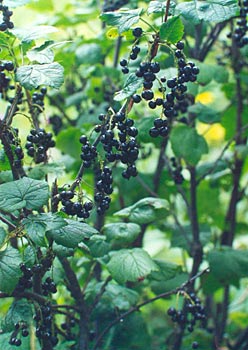Relatives
Ribes altissimum Turcz. ex Pojark. - Tallest currant.
Taxonomic position.
Family Grossulariaceae DC., genus Ribes L.Synonyms.
Black wild currant.Morphology and biology.
Shrub that grows up to 2-3 m tall. Young shoots are straight, ascending, bare or glandular-bristly, with reddish brown bark cracking and flaking off lengthwise in wide stripes. Leaves have 3-5 sharp, more often broadly triangular, uniform lobes, almost square-shaped, 3-6 cm in diameter, with uneven obtuse dentation, compact, dark green, bare or glandular-bristly or dotty-glandular along the underside veins. Flowers are bell-shaped, grouped 7-25 in racemes 2-6 (8) cm long. Petals are bare, varying from yellow to purple fringed by a yellow stripe. Berries are purple-black, without wax coating, globular, up to 5-7 mm in diameter, bare, sour, edible. Blossoms usually in June; berries ripen in late July/mid-August. Propagated by seed and summer or hardwood cuttings. 2n = 16.Distribution.
Occurs in the Altai-Sayan mountain region, southwestern coastal areas of Baikal, and Mongolia.Ecology.
Mesophyte, petrophyte, psychrophyte. Heliophilous. Grows predominantly in stony places within the mountain forest zone, sometimes intruding into the loach zone of the mountains where it occurs on rocky tundra.Utilization and economic value.
Used for food (berries). Nectariferous, medicinal and ornamental plant. Interesting as a source for breeding. Frost-resistant. Berries contain large amounts of vitamin P and ascorbic acid.References:
Brezhnev, D.D., Korovina, O.N. 1981. Wild relatives of cultivated plants in the USSR flora. Leningrad: Kolos, p. 151.Koropachinskiy I.Yu., Vstovskaya T.N. 2002. Woody plants of the Asian part of Russia. Novosibirsk: Publishing House of SB RAS, Branch "Geo", p. 271-272.
Malyshev L.I., Peshkova G.A., eds. 1994. Flora of Siberia. Vol. 7. Berberidaceae - Grossulariaceae. Novosibirsk: Nauka, p. 210-211.


